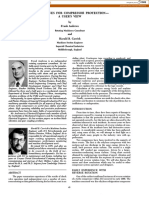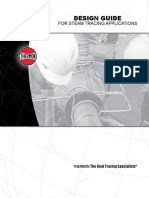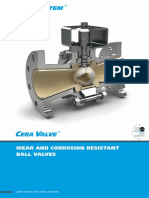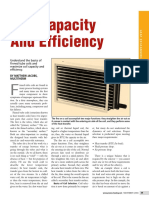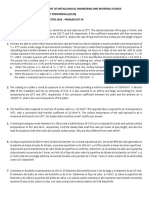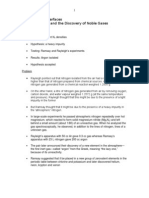Heaters Film and Bulk
Heaters Film and Bulk
Uploaded by
Fathy Adel FathyCopyright:
Available Formats
Heaters Film and Bulk
Heaters Film and Bulk
Uploaded by
Fathy Adel FathyOriginal Description:
Copyright
Available Formats
Share this document
Did you find this document useful?
Is this content inappropriate?
Copyright:
Available Formats
Heaters Film and Bulk
Heaters Film and Bulk
Uploaded by
Fathy Adel FathyCopyright:
Available Formats
Cover Story Part 1: Heat Flux And Film Temperature In Fired, Thermal-Fluid Heaters...
Page 1 of 24
Store | Buyers' Guide | Conferences | Webinars | White Papers | The Magazine | Awards | Editorial Submissions | Jobs | DecisionBriefs
Advertise with us
Article
Email
Comments (0)
Print
Clip & File
Tweet
More Heat Exchangers, Condensers &
Coolers
Unlocking the Secrets of Plate-and-Frame Heat Exchangers
Processing & Handling :: Thermal & Energy Management :: Heat Exchangers, Condensers &
Coolers
A new tantalum line of heat exchangers for corrosive
service
December 1, 2008
Optimization of a Steam Network
Cover Story Part 1: Heat Flux And Film Temperature In Fired,
Thermal-Fluid Heaters
The importance of these factors is often overlooked. Learn how to determine if you are
overheating the fluid film in your system
R.G. Pelini RGP Engineering
The New Face of Heat Exchangers
Use this compact heat exchanger for high-pressure dry-gas
seals
Archives
Related Stories
Engineering Practice: Get More From Vertical
Thermosiphon Reboilers
Cover Story Part 2: Heat Transfer Fluids: Maintaining the
System
In a fired thermal fluid heater, a thermal fluid is heated by the metal
surfaces of a fired heater or fluegas heat-recovery exchanger. Generally,
the heat input rate is controlled to achieve some desired bulk-fluid
temperature exiting the heater. However, in being heated to the outlet
setpoint, the fluid film in contact with the heating surface is always exposed
to a higher temperature than the bulk fluid. In many applications it is the
fluid film temperature, not the bulk fluid temperature, that limits the duty of
the heater and the usable life of the fluid. (For more on fluid life, see Part 2
of this report)
Immersion Heaters: Selection & Implementation
Heat Exchangers: Tube-to-Tubesheet Joint Tightness
Newsfront: The Heat Is On
Looking to purchase a back issue of
Chemical Engineering? Inquire here.
Importance of film temperature
Thermal fluids include glycol-water solutions, hydrocarbon oils, silicone oils,
molten salts and liquid metals. Most common in the chemical process
industries (CPI) are hydrocarbon oils, either petroleum-based or synthetic,
which are available for use over a wide range of operating temperatures.
Some are optimized for low-temperature operation and others for good
thermal stability at temperatures up to 750F. For any fluid, there are use
temperature limitations. The maximum bulk-fluid-temperature limit is the
fluid manufacturers recommended maximum use temperature for the flowing bulk-fluid stream. The fluid
temperature exiting the heater is easily measured and it usually is the process variable used to control the
heat input to a thermal fluid heater. In designing a thermal-fluid heat-transfer system, the thermal fluid and
heat transfer equipment are selected based on the intended fluid operating temperature, so there is usually
little confusion about the proper bulk-fluid-temperature setpoint.
The film temperature is a different matter. The fluid film temperature is not usually measured directly, and it
must be estimated by the manufacturer of the thermal fluid heater in the design of the equipment. Two
different heaters may operate at the same heat duty, fluid flowrate, and bulk-fluid outlet temperature, and yet
they may have significantly different film-temperature profiles. The film temperature is an important design
feature for several reasons:
Fluid degradation: Fluid degradation begins in the fluid film, as this is where the fluid is hottest. For typical
thermal oils, the fluid decomposition rate doubles for roughly every 18F increase in fluid temperature [ 1]. It is
not unusual for the maximum fluid-film temperature to exceed the heater outlet temperature by 80F or more,
with degradation rates in the film exceeding those in the bulk fluid by a factor of 20 or more. Shortened fluid
life can be a costly result.
Fouling: Overheating of only the small fraction of the fluid volume in the film may lead to fouling of the heat
transfer surface. Fouling requires higher heat input rates and even hotter metal temperatures to achieve the
same duty, which only accelerates the fouling rate. If the heat users become fouled, a reduction in capacity
can result.
Coke formation: Formation of abrasive coke particles due to fluid cracking reduces the life of pump seals,
bearing surfaces, and valve seats.
Our LinkedIn group is now
over 23,000 members
strong!
Join other CPI
professionals from all
over the globe and
share best practices,
Low-boiling byproduct formation: Formation of low-boiling byproducts of thermal decomposition requires
venting to prevent vapor accumulation in the heater and contributes to fluid loss.
expertise, concerns
Overall averages can mislead
Provide feedback to
The overall average heat flux ( q) is equal to the total heat duty ( Q) divided by the total heat-transfer surface
area ( A). Often, this is the only information available to the purchaser of a heater when comparing heater
designs. Unfortunately, the overall average heat flux (and the overall average film temperature that results
from it) gives little or no information about the localized conditions in the heater where fluid degradation
occurs.
Quantifying film temperature
and more.
Chemical Engineering
Editors
Current members
represent Worley Parsons,
DuPont, SABIC, Fluor, Air
Products, LyondellBasell,
Nalco, Dow Chemical, Dow
Corning, BASF, Jacobs
Engineering, ExxonMobil,
Shell, Chevron and more.
http://www.che.com/nl/YToyOntpOjA7czo0OiI0Mzg0IjtpOjE7czo4NjoicHJvY2Vzc...
01/06/2014
Cover Story Part 1: Heat Flux And Film Temperature In Fired, Thermal-Fluid Heaters... Page 2 of 24
For any differential portion of heat-transfer surface area ( dA), the differential rate of heat transferred ( dQ)
may be related to the temperature difference between the fluid film temperature in contact with the inside
heating surface ( T f) and the bulk fluid temperature ( T) at that same location.
dQ
We also offer the following
subgroup for more targeted
discussions:
h i dA i (T f T)
(1)
For any localized area we have:
dQ/dA i
qi
h i (T f T)
Join Now
h i T
Water Treatment &
euse
f
(2)
In Equation (2), the heat transferred per unit inside heat-transfer area ( dQ/dA i) is defined as the heat flux ( q
i). The difference between the fluid film temperature and the bulk temperature ( T f T) is usually referred to as
the film temperature rise ( T f). The inside, film heat-transfer coefficient is, by definition, equal to q i T f.
Therefore, the fluid film temperature may be calculated as follows:
T
T + T
T + q i /h i
(3)
In the process equipment industry it is customary to express the heat flux as q o Q A o rather than q i. That
is, the heat flux is expressed as the heat transfer rate per unit of external heat-transfer surface area. With
these definitions, q i q o A o A i, and Equation (3) becomes:
T f = T + (q o /h i)(A o /A i) = T + q o /h io
( )
Equation ( ) is the working equation for film temperature. It is common to use the form with h io (defined as h i
A i A o, the inside, film heat-transfer coefficient referenced to the outside surface area). For round tubes, h io
h i d i d o.
A typical temperature profile in a thermal-fluid-heater tube is shown in Figure 1. To estimate the fluid film
temperature at any given location in a thermal fluid heater, all that is required is an estimate of T, q o and h io
at that location.
Search the
uyers Guide
By Company
By Product
Browse By Category
Plant Cost Index
Facts at our Fingertips archive
Ask the Experts
ack Issues
Jump To A Previous Issue...
Dont be fooled by common misconceptions. It is important to dispel a few oversimplified notions that are often
repeated in the industry literature. The film temperature rise is equal to q o h io , the ratio of heat flux to heattransfer coefficient. No one variable by itself determines the film temperature.
Nevertheless, it is common to find comments such as "film temperature will not be a problem if q o is less than
10,000 Btu (ft 2 h)" or "use oversized radiant-heat-transfer area to assure low film temperature" or "film
temperature can be kept low by maintaining a fluid velocity of at least 7 ft s". In fact, for any given filmtemperature limit, the allowable amount of T f depends strongly on the bulk temperature ( T). If a fluid is
used at a bulk temperature well below its allowable film temperature, more film-temperature rise is allowed.
And there can never be any single heat-flux limit or fluid velocity requirement that will assure low film
temperature. It is always the ratio of q o h io that determines the film temperature rise, and all three variables
T, q o and h io that determine the film temperature.
Determination of film temperature at any given location in a thermal fluid heater requires knowledge of the
values of T, q o and h io at that location. Heat fluxes averaged over an entire heater will give no meaningful
result if it is the maximum film temperature that is of interest.
Next, well consider how to estimate T, q o and h io at key locations in a thermal fluid heater.
Radiant zone heat flux
In a thermal fluid heater, the overall average heat flux is easily calculated. It is simply the total heat duty
divided by the total heat-transfer surface area. Unfortunately, this overall average is of little use in the
estimation of maximum film temperature. Before proceeding with the calculation of local-maximum film
temperatures, we will take a look at a few of the more common types of fired heater designs and determine
the average heat flux in the radiant zone. If the average radiant-zone heat flux is known, there are reasonable
empirical methods to estimate maximum local flux.
In every heater type, there is a zone of heat transfer where the primary mode of heat transfer is radiant. In this
zone, heat transfer by radiation typically accounts for over 80 of the total heat transferred (except in the
convective heater style, discussed later, where heat transfer may be predominantly convective even in the
hottest tube rows). Let us now consider the distribution of radiant and convective heat in the radiant zone of a
thermal fluid heater.
Tangent-tube helical-coil heaters. For tangent-tube helical-coil heaters of the type shown in Figure 2, the
radiant zone is considered to be the inner side of the cylinder formed by successive turns of the helical coil.
For a two-pass single-helical heater, the radiant zone is slightly less than 50 (typically 5
8 ) of the total
coil surface area. In the case of a three-pass double-helical heater, the area of the radiant zone is typically 20
23 of the total. Since the surface area is easily calculated for any given heater, the value of A o for the
radiant zone can be readily determined in any case.
http://www.che.com/nl/YToyOntpOjA7czo0OiI0Mzg0IjtpOjE7czo4NjoicHJvY2Vzc...
01/06/2014
Cover Story Part 1: Heat Flux And Film Temperature In Fired, Thermal-Fluid Heaters... Page 3 of 24
The radiant zone duty ( Q r) must be determined so that an average radiant-zone heat flux ( q r) may be
calculated. In general, the calculation of Q r depends upon many factors, including the furnace geometry,
combustion conditions and fluid temperature. Detailed procedures for radiant zone calculations are beyond the
scope of this article, but there are well-established, quasi-theoretical techniques for determining radiant-zone
performance [ 2].
The heater vendor must calculate Q r in order to properly design a heater or rate its performance, and the
values of Q r and A o (or at least q r Q r A o) should be reported to the potential purchaser for evaluation and
comparison of bids. Due to the numerous variables that apply to radiant calculations, the calculation of radiant
heat transfer has some inherent uncertainties. Nevertheless, in most applications the radiant-zone, exit
temperature of the fluegas can usually be predicted to within 100F, so that the radiant zone duty (as a
percentage of the total duty) can be predicted within 3 percentage points. The radiant zone duty in a twopass heater can account for anywhere from 0 to 85 of the total heat-transfer duty (a typical value is 72 ).
In a three-pass heater, it is sometimes possible to achieve more convective duty, especially for applications
with low fluid-inlet temperature. When this is the case, the radiant duty is usually in the range of 50 to 75 of
the total (a typical value is 2 ).
So, if the overall average heat flux for the heater is, say ,000 Btu (ft 2 h) in a given two-pass heater, the
average heat flux in the radiant zone may exceed 1 ,000 Btu (ft 2 h), see Example 1. Three-pass heaters
always have much more convective surface area than radiant area, so the disparity between average radiantzone flux and overall average flux tends to be higher. Consider the heater in Example 2, where the overall
average heat flux is only 7,1 0 Btu (ft 2 h) but the radiant zone average is 1 , 00 Btu (ft 2 h).
API-style heaters. Heaters built in accordance with American Petroleum Institute (API) Standard 5 0 always
have tubes that are spaced at some distance apart, usually twice the nominal tube diameter. In API thermal
fluid heaters (Figure 3), an overall heat-flux calculation is seldom even reported, as it has little relation to the
radiant zone flux. The convective section typically utilizes both bare tubes and extended surface tubes (fins or
studs), with the result that the convective zone often has a large, external surface area that would skew any
average based on total surface. In these heaters, the convective surface area does not have any fixed relation
to the radiant area and is varied for each particular application. (In contrast, in a tangent-tube helical-coil
heater the area ratio of radiant and convective surface is fixed for any given coil diameter.) Because of this
variation, the radiant duty can vary from 0 to 85 of the total duty. adiant-zone and convective-zone heat
duties, areas and heat fluxes must be reported separately in order to achieve a proper evaluation of a design
(Example 3). A good rule of thumb for API heaters in thermal fluid service is to assume that 75 of the duty is
occurring in the radiant zone.
Local-maximum heat flux and maximum film temperature
After determining the average heat flux in the radiant zone, it is a simple matter to calculate the average fluidfilm-temperature rise in the radiant zone. It is the average radiant-zone heat flux divided by the average value
of h io. (More on the calculation of h io will be presented later.) Calculation of the maximum film temperature
requires a bit more work.
Tangent-tube, helical coil heaters. First we will consider the case of tangent-tube helical coils. By simple
geometrical considerations, it is easily shown that the radiant heat flux at the coil surface directly normal to the
http://www.che.com/nl/YToyOntpOjA7czo0OiI0Mzg0IjtpOjE7czo4NjoicHJvY2Vzc...
01/06/2014
Cover Story Part 1: Heat Flux And Film Temperature In Fired, Thermal-Fluid Heaters... Page 4 of 24
radius of the radiant cylinder is higher than the average over the entire curved surface by a factor of 2
1.57. This is the tube-circumference, heat-flux variation factor, F C. Strictly speaking, this factor applies to
direct radiation only. A portion of the radiant zone duty is convective, and it does not necessarily vary by this
same ratio. However, it is to be expected that the washboard surface of the coil has a higher convective
coefficient at the portion normal to the cylinder radius than in the curved triangular space where the tubes
touch. Since the convective contribution is a relatively small portion of the radiant zone flux, the ratio of
maximum to average flux around the half-tube circumference is generally taken to be 1.57.
In addition to circumferential flux variation around the tube surface, there is also a variation in heat flux
longitudinally in the radiant zone. This longitudinal flux is difficult to quantify accurately, as it depends on the
fuel characteristics, flame length, and excess air levels. Some typical profiles of this factor ( F L) are given in
Figure . For gas-fired heaters with a flame length equal to 50
0 of the radiant cylinder length, the peak
flux occurs at a distance of about 33 of the radiant zone length from the burner. At this location the
longitudinal heat flux factor ( F L) will be in the range of 1.05 to 1. 0, with 1.10 being a typical value for a
single, long-flame forced-draft burner.
Finally, the localized heat flux is affected to some extent by the localized temperature of the tube surface
being irradiated. The factor accounting for this effect of tube-surface temperature variation ( F T) is generally
close to unity in a thermal fluid heater. A typical value for F T is 0. at the location of maximum heat flux.
Details on how to estimate F T more precisely are given in ef. [ 5].
Putting all the factors together, the maximum radiant-zone heat flux may be related to the average as follows:
qm
FCFLFTqr
(5)
Assuming F C
factor of 1.71.
1.57, F
1.10, and F
0.
, the localized maximum heat flux will exceed the average by a
If we know T and h io at this location, we can now calculate the film temperature. eep in mind, though, that
the fluid is not at its final outlet temperature at this point of maximum heat flux.
To be sure to determine the maximum film temperature properly, the film temperature must also be calculated
at the heater outlet. The calculation procedure is the same, except that in this case F L is evaluated at the coil
outlet location, typically at one end or the other of the radiant zone, and T is now the fluid outlet temperature.
See Example 5 for a calculation of maximum film temperature in a two-pass, helical-coil heater.
API-style heaters. The estimation of the maximum, radiant-zone heat flux in these heaters is similar to the
case for tangent-tube heaters, but the procedure is slightly more complicated. Consider first that in the case of
tangent-tube, coil heaters, the radiant surface is considered to be the semicircular portion of the coil
circumference facing the flame. In API heaters, by contrast (Figure 5), the tubes are spaced apart with
reradiating refractory behind the tubes. Therefore, the average flux calculation for API heaters is based on the
entire tube circumference and the distribution of radiant heat around the tube is a function of tube spacing.
Because of the tube spacing and the fluegas flow pattern in this type of heater, the convective component of
heat transfer is significant (typically about 15 of the total radiant-zone flux), and tends to be more
pronounced behind the tubes.
Heat flux distribution around the circumference of fired heater tubes has been studied in depth over the years,
and various authors have presented data and estimation techniques to quantify the heat distribution [ 3, 4].
The procedure has been more or less standardized in API Standard 530, Appendix C [ 5]. The working
equation for calculating the maximum heat flux at any point in the coil is as follows:
qm
F C F L F T( q r
q rc)
q rc
( )
For Equation ( ), F C, F L and F T are the heat-flux variation factors already discussed in the previous section
on tangent-tube helical coils. Since the entire tube circumference (as opposed to only half for tangent-tube
helical-coil heaters) is considered in calculating q r for an API heater, it is not surprising that F C tends to be
somewhat higher for an API heater. The value of F C varies with tube spacing, but typically ranges from 1.85
to 1. 5 for tubes made of standard pipe sizes that are spaced at twice the nominal pipe diameter. A graph of F
C versus tube spacing is presented in Figure . The term F C can tend to be an overestimate, as it assumes
that refractory surfaces absorb all incident radiation. eflections will tend to reduce the actual value of F C.
http://www.che.com/nl/YToyOntpOjA7czo0OiI0Mzg0IjtpOjE7czo4NjoicHJvY2Vzc...
01/06/2014
Cover Story Part 1: Heat Flux And Film Temperature In Fired, Thermal-Fluid Heaters... Page 5 of 24
Note that the convective component of the radiant-zone heat flux is subtracted from the average before
correcting for variation in the radiant component of the flux. In the API 530 procedure, the convective term in
Equation ( ) is assumed to be a constant around the tube circumference. In fact, studies have shown that the
convective effect tends to be greatest in the areas around the circumference where the direct radiant flux is
lowest (that is, between the tubes and the refractory) [ 3]. Consequently, Equation ( ) is slightly conservative,
producing a slight overestimation of the true maximum radiant flux.
See Example
an illustration of the use of Equation ( ).
Convective heaters
For convective thermal-fluid heaters (Figure 7), the maximum heat flux usually occurs near the hot, gas-inlet
end of the coil, either at the first bare-tube row or at the first finned-tube row. For the first bare row of tubes,
the heat flux may be calculated using Equation ( ). The radiant portion of the flux is generally a smaller
fraction of the total in this case, as the tubes have no direct view of the flame. Nevertheless, the nonluminous
gas radiation from the gas volume beneath the coil can produce substantial heat flux at the first tube row,
usually exceeding the convective flux. The fraction of the total heat radiated by the hot gas that is absorbed in
each tube row may be calculated as described by Ganapathy [ 6]. In this case, F C is slightly higher than for a
furnace with refractory behind the tubes, and F L 1.0.
Usually, however, convective heaters are specifically designed to operate at reduced gas temperatures where
radiative heat transfer is a smaller fraction of the total in relation to other fired heater types. The maximum
heat flux often occurs at the row of finned tubes exposed to the hottest fluegas and in this area the heat
transfer is predominantly convective. To determine the maximum film temperature in a convective heater, the
heat flux and film temperature should be checked at the hot, gas-inlet end and at any tube row where the fin
density is increased.
When calculating peak heat flux in a convective bundle, it must be considered that the convective heattransfer coefficient at the leading edge (gas inlet) of a given tube row is about 1.5 times the circumferential
average coefficient, and the gas temperature to be used in calculating the peak flux is the inlet gas
temperature for that tube row, not the average.
Calculating film temperature
Once the maximum, radiant-zone heat flux is determined, the film temperature can be calculated. The first
step is calculation of h i.
Calculation of h i is straightforward. The value of h i may be calculated by various correlations available in
literature. One widely used correlation is the Dittus-Boelter Equation [ 7]:
hi
0.02 3( k d i) e 0.8 Pr 0. (
w)
0.1
(7)
Equation (7) applies to straight tubes, but it is also recommended for calculating peak film temperature in
helical coils. Although the circumferential-average h i is greater in a helical coil than in a straight tube by the
factor (1 3.5 d i D coil), studies have shown that the enhancement in h i occurs at the outer radius of the coil.
In studies of flow in curved channels, the local value of h i at the inner coil radius is typically less than the
circumferential average [ 9], and since that is where the maximum radiant flux occurs, it is recommended not
to credit any enhancement in h i for helical flow at the point of peak heat flux.
0.1
The factor (
is generally very close to unity and may be assumed to be 1.0 for most calculations. The
w)
rest of the fluid properties needed to calculate h i may be found in the fluid vendors literature. Having
calculated h i, h io is then calculated by h io h i d i d o.
http://www.che.com/nl/YToyOntpOjA7czo0OiI0Mzg0IjtpOjE7czo4NjoicHJvY2Vzc...
01/06/2014
Cover Story Part 1: Heat Flux And Film Temperature In Fired, Thermal-Fluid Heaters... Page 6 of 24
Checking the result
T f.
Calculate the ratio of the estimated T f to the allowable maximum value of T f.
If T f is more than 80% of the allowable, investigate more carefully.
Be extra cautious about any design that uses high radiant heat flux to make up for a large, allowable T f.
Consider future process changes.
Install tube thermocouples in any application where film temperature is a concern.
Summing up
Demand quantitative information from the vendor.
For any type of heater, the radiant and convective duties, surface areas, and heat fluxes must be reported
separately.
The average and local-maximum radiant heat fluxes should be reported.
The film temperature at any location is a function of three variables: bulk fluid temperature, heat flux, and film
heat-transfer coefficient.
In helical coil heaters, whether of the tangent-tube or API type, the maximum-heat-flux location may not
coincide with the maximum film temperature.
For prospective purchasers: Question the heater manufacturer!
If film temperature appears to be critical (if it approaches the limit closely) measure it!
Edited by Rebekkah Marshall
Example 1
Qr
qr
Q Ao
Q r A o,r
http://www.che.com/nl/YToyOntpOjA7czo0OiI0Mzg0IjtpOjE7czo4NjoicHJvY2Vzc...
01/06/2014
Cover Story Part 1: Heat Flux And Film Temperature In Fired, Thermal-Fluid Heaters... Page 7 of 24
Example
qr
Q Ao
Q r A o,r
Example
Q
Q Ao
qb
Q A o,b
qr
Q r A o,r
Example
FL
q rc
qm
F c F L F T (q r q rc)
do
qm
q rc
qr
Example
di
hi
S m
h io
nits
Maximum lux
rea
Location of maximum heat flux:
qm
eater
utlet
FCFLFTqr
T
h io
Tf
q m h io
561F
Coil outlet:
FL
qm
T
io
Tf
q m h io
609F
http://www.che.com/nl/YToyOntpOjA7czo0OiI0Mzg0IjtpOjE7czo4NjoicHJvY2Vzc...
01/06/2014
Cover Story Part 1: Heat Flux And Film Temperature In Fired, Thermal-Fluid Heaters... Page of 24
menclature
Ai
Ao
A o,b
A o,r
Cp
D coil
di
do
FC
FL
FT
hi
h io
ho
k
kw
Pr
Cp
Q
Qr
qi
qm
qo
qr
q rc
Re
div
R film,o
h io
R fouling
R wall
ri
ro
T
Tf
T
T fouling
Tw
v
uth r
Robert Pelini
e erences
Process Heating
Chem. Eng.
http://www.che.com/nl/YToyOntpOjA7czo0OiI0Mzg0IjtpOjE7czo4NjoicHJvY2Vzc...
01/06/2014
Cover Story Part 1: Heat Flux And Film Temperature In Fired, Thermal-Fluid Heaters... Page of 24
Pet.
Refiner
Hydrocarbon Process.
Int. J. Heat Mass Transfer
http://www.che.com/nl/YToyOntpOjA7czo0OiI0Mzg0IjtpOjE7czo4NjoicHJvY2Vzc...
01/06/2014
Cover Story Part 1: Heat Flux And Film Temperature In Fired, Thermal-Fluid Heat... Page 10 of 24
http://www.che.com/nl/YToyOntpOjA7czo0OiI0Mzg0IjtpOjE7czo4NjoicHJvY2Vzc...
01/06/2014
You might also like
- Chemsheets A2 1210 Extras Kinetics ANSDocument3 pagesChemsheets A2 1210 Extras Kinetics ANSDon SunilNo ratings yet
- Meshkat Design Heat ExchangerDocument36 pagesMeshkat Design Heat ExchangerjdedfvNo ratings yet
- Dmitriyev & Pisarenko (1984)Document3 pagesDmitriyev & Pisarenko (1984)Francisco OppsNo ratings yet
- RescoDocument2 pagesRescocanakyuzNo ratings yet
- Каталог промышленных компрессоров открытого типа/сальниковые компрессоры HOWDEN (Шотландия)Document2 pagesКаталог промышленных компрессоров открытого типа/сальниковые компрессоры HOWDEN (Шотландия)chelnintsevNo ratings yet
- Tube Layout DrawingDocument1 pageTube Layout DrawingAnonymous AyDvqgNo ratings yet
- Stability Analysis of Natural Circulation SystemsDocument7 pagesStability Analysis of Natural Circulation SystemsAnonymous knICaxNo ratings yet
- Conley Et Al. - 2018 - 2.24 Insulation MaterialsDocument36 pagesConley Et Al. - 2018 - 2.24 Insulation Materialsminsara madtNo ratings yet
- Air Cooled Heat Exchanger Preliminary SelectionDocument4 pagesAir Cooled Heat Exchanger Preliminary SelectionAA GGNo ratings yet
- 4-2 Isentropic Flow Through NozzlesDocument25 pages4-2 Isentropic Flow Through NozzlesAlif Nur FirdausNo ratings yet
- 03 Heat ExchangeDocument69 pages03 Heat Exchangeazzuddin100% (1)
- Introduction To Heat Exchangers: Transport Phenomenon (CH 306)Document101 pagesIntroduction To Heat Exchangers: Transport Phenomenon (CH 306)Jhoab Jchs ChaconNo ratings yet
- Catalog C-1 Accumulators and ReceiversDocument17 pagesCatalog C-1 Accumulators and ReceiversHewa AkreyNo ratings yet
- Process HeatingDocument9 pagesProcess HeatingGajanan GaikwadNo ratings yet
- Tema2007 140806051822 Phpapp02 PDFDocument298 pagesTema2007 140806051822 Phpapp02 PDFAjit PatilNo ratings yet
- Design Considerations For Compact Heat ExchangersDocument16 pagesDesign Considerations For Compact Heat ExchangersHaunted HunterNo ratings yet
- Sabroe 001 PDFDocument43 pagesSabroe 001 PDFMelissa MaciasNo ratings yet
- AHU Design ExampleDocument2 pagesAHU Design ExampleShravanNo ratings yet
- Ulman Part 10Document1,000 pagesUlman Part 10Yana RahmadaniNo ratings yet
- Liquid Monopropellant CombustionDocument4 pagesLiquid Monopropellant Combustionherdi sutanto adigunaNo ratings yet
- Alfa Laval Solidc Pump Instruction Manual Ese00797enDocument36 pagesAlfa Laval Solidc Pump Instruction Manual Ese00797enDavid Apaza Hurtado0% (1)
- Compressor Discharge Check ValveDocument8 pagesCompressor Discharge Check ValverajeshbharatNo ratings yet
- TSP0013 Steam Tracing DesignDocument23 pagesTSP0013 Steam Tracing DesignFabio TemporiniNo ratings yet
- Product Handbook Complete Product Line 1st Edition PDFDocument919 pagesProduct Handbook Complete Product Line 1st Edition PDFHADINo ratings yet
- Heat Transfer Tech Bulletin FinalDocument43 pagesHeat Transfer Tech Bulletin FinalsaltbathNo ratings yet
- Heat Transfer Documentation: Release 1.0.3Document285 pagesHeat Transfer Documentation: Release 1.0.3Ahmed HassanNo ratings yet
- Samson Valve For High Temperature PDFDocument36 pagesSamson Valve For High Temperature PDFNARENDRA PATELNo ratings yet
- Cinetica Rop PDFDocument14 pagesCinetica Rop PDFDiana Isabel Franco ZambranoNo ratings yet
- Detail DesignDocument67 pagesDetail DesignBHAVISHA GOHILNo ratings yet
- 11 Heat Transfer To The Riser Wall of A Circulating Fluidised Bed CFBDocument8 pages11 Heat Transfer To The Riser Wall of A Circulating Fluidised Bed CFBMahesh DasarNo ratings yet
- Exergetic Analysis by George TsatsaronisDocument6 pagesExergetic Analysis by George TsatsaronisEdson BenitesNo ratings yet
- Fouling in Heat Exchangers - PRDDocument47 pagesFouling in Heat Exchangers - PRDPradyumna DhamangaonkarNo ratings yet
- 1 Chaker - Evaporative Cooling of Gas Turbine EnginesDocument12 pages1 Chaker - Evaporative Cooling of Gas Turbine Engineshermez19No ratings yet
- Begg Cousland - Mesa Redonda 2010 - Mist Eliminators - Life StoriesDocument41 pagesBegg Cousland - Mesa Redonda 2010 - Mist Eliminators - Life StoriesDaniel BerriosNo ratings yet
- Steam Powered Absorption Chiller Installation and Operation Manual TTDocument44 pagesSteam Powered Absorption Chiller Installation and Operation Manual TTromi_hamdani0% (1)
- Heat Pump 2Document100 pagesHeat Pump 2hvactrg1No ratings yet
- Heat Recovery SystemDocument3 pagesHeat Recovery SystemGirish100% (1)
- InTech-Fouling of Heat Transfer Surfaces PDFDocument40 pagesInTech-Fouling of Heat Transfer Surfaces PDFTrần Tuấn VũNo ratings yet
- ALPEMA Standards Rev1Document8 pagesALPEMA Standards Rev1nattusharanNo ratings yet
- WSAC Alternative To CWDocument47 pagesWSAC Alternative To CWweweqweqwNo ratings yet
- Steam Distribution CourseDocument79 pagesSteam Distribution CoursebinhjukiNo ratings yet
- G-Me-250 - 2 Genreal Standard For Pressure and Vacuum Relief DevicesDocument35 pagesG-Me-250 - 2 Genreal Standard For Pressure and Vacuum Relief DevicesSaleh EttehadiNo ratings yet
- A Review of Heat Exchanger Tube Bundle Vibrations in Two-Phase Cross-FlowDocument19 pagesA Review of Heat Exchanger Tube Bundle Vibrations in Two-Phase Cross-FlowPeerasak ArunNo ratings yet
- Agitated VesselDocument8 pagesAgitated VesselBharatShethNo ratings yet
- PVRC Gasket ConstantDocument5 pagesPVRC Gasket Constantkimyt250651No ratings yet
- Peep Door PresentationDocument37 pagesPeep Door Presentationashutosh_garg_10No ratings yet
- Kimre - Innovative Clean Air TechnologiesDocument16 pagesKimre - Innovative Clean Air TechnologiesKimre Inc100% (1)
- Numerical Investigation of Ejectors For Ejector Refrigeration SystemDocument6 pagesNumerical Investigation of Ejectors For Ejector Refrigeration SystemInternational Journal of Innovative Science and Research TechnologyNo ratings yet
- Coil Capacity EfficiencyDocument3 pagesCoil Capacity EfficiencyChínhÂuNo ratings yet
- Engineering Page - Heat Exchangers - Typical Overall Heat Transfer Coefficients PDFDocument2 pagesEngineering Page - Heat Exchangers - Typical Overall Heat Transfer Coefficients PDFJahidul IslamNo ratings yet
- Fundamentals of Heat Exchanger Design: Ramesh K. ShahDocument2 pagesFundamentals of Heat Exchanger Design: Ramesh K. ShahGaettan KatambaNo ratings yet
- ISA SymbolsDocument1 pageISA SymbolsmustafasandikciNo ratings yet
- Basics of Industrial Heat TransferDocument12 pagesBasics of Industrial Heat TransferPinaiNo ratings yet
- Heat TransferDocument13 pagesHeat TransferSARATH KRISHNAKUMARNo ratings yet
- Plate and Frame Heat ExchangersDocument6 pagesPlate and Frame Heat ExchangersAndrés Ramón Linares100% (1)
- 0910 Cool Flash - Edition 17-1Document8 pages0910 Cool Flash - Edition 17-1miguel_marshNo ratings yet
- Maximizing Heat-Transfer Fluid LongevityDocument8 pagesMaximizing Heat-Transfer Fluid LongevityDefenceDogNo ratings yet
- L2-0 - MODULES - Pinch Technology Combined NotesDocument62 pagesL2-0 - MODULES - Pinch Technology Combined NoteskietNo ratings yet
- Plate Heat ExchangersDocument7 pagesPlate Heat ExchangersBaneMarkovicNo ratings yet
- Temperature Control PDFDocument60 pagesTemperature Control PDFKmilo GiraldoNo ratings yet
- Waste Heat Recovery TranscriptDocument22 pagesWaste Heat Recovery Transcriptfernanda boldtNo ratings yet
- Electric PotentialDocument7 pagesElectric PotentialJumar CadondonNo ratings yet
- Basic Principle and Theoretical Background of PIGEDocument21 pagesBasic Principle and Theoretical Background of PIGEsajjad hussainNo ratings yet
- Eb 951 TDSDocument1 pageEb 951 TDSAntonella EspinozaNo ratings yet
- Superabsorbent Hydrogels Based On Polysaccharides For Application in Agriculture As Soil Conditioner and Nutrient Carrier: A ReviewDocument57 pagesSuperabsorbent Hydrogels Based On Polysaccharides For Application in Agriculture As Soil Conditioner and Nutrient Carrier: A ReviewCesarNo ratings yet
- Madriaga, Ray Francis S.: R N V WDocument2 pagesMadriaga, Ray Francis S.: R N V WRAYNo ratings yet
- JEE T-23 STUDY PLAN (2021-22-23) Target: JEE - 2023 (SCH Code: 211124JA-ES23-02002) Physics Chemistry MathematicsDocument5 pagesJEE T-23 STUDY PLAN (2021-22-23) Target: JEE - 2023 (SCH Code: 211124JA-ES23-02002) Physics Chemistry Mathematicspayal garg50% (2)
- Multicomponent Distillation PDFDocument11 pagesMulticomponent Distillation PDFvinod kumarNo ratings yet
- Year 9 Summer Examination ChecklistDocument3 pagesYear 9 Summer Examination Checklistrg7No ratings yet
- G30 Developer MSDS ABDocument6 pagesG30 Developer MSDS ABramadhanNo ratings yet
- AlcoholDocument45 pagesAlcoholMichaelWongNo ratings yet
- Etea 2019Document7 pagesEtea 2019Izhar RahmanNo ratings yet
- Chapter 12 Thermodynamics PDFDocument94 pagesChapter 12 Thermodynamics PDFNitish MehraNo ratings yet
- CSEC Chemistry June 2007 P02Document12 pagesCSEC Chemistry June 2007 P02rampee charlesNo ratings yet
- Unit 5-2 PolymersDocument13 pagesUnit 5-2 Polymersrehansayyied44No ratings yet
- A Study of Accelerators For Epoxy-AmineDocument19 pagesA Study of Accelerators For Epoxy-AmineVipin Shukla100% (1)
- Pidc Unit 1-1Document88 pagesPidc Unit 1-1Gauri DetheNo ratings yet
- Problem Set 4Document1 pageProblem Set 4Dniel Suarez RNo ratings yet
- CBSE Class X Science Chap 2 - Acids, Bases and Salts - BasicsDocument10 pagesCBSE Class X Science Chap 2 - Acids, Bases and Salts - BasicsMd RabbaniNo ratings yet
- William RamsayDocument5 pagesWilliam RamsayNicholas OwNo ratings yet
- Dual Nature of Radiation & Matter DPPDocument4 pagesDual Nature of Radiation & Matter DPPChristopher NolanNo ratings yet
- 0 Ebb 55Document10 pages0 Ebb 55miguel angel rubiano guevaraNo ratings yet
- Ch.3 Catalase Worksheet AnswerDocument2 pagesCh.3 Catalase Worksheet AnswerJoe GuNo ratings yet
- Chapter 7 PDFDocument36 pagesChapter 7 PDFRbtl BañosNo ratings yet
- Asymmetric HydroborationDocument22 pagesAsymmetric HydroborationsaheedvkNo ratings yet
- ChemiluminescenceDocument3 pagesChemiluminescenceapi-318284296No ratings yet
- Advanced Welding Processes PDFDocument9 pagesAdvanced Welding Processes PDFlovaldes62100% (1)
- Chemistry Notes - SolutionsDocument3 pagesChemistry Notes - Solutionsapi-256649613No ratings yet
- Drying AgentsDocument24 pagesDrying Agentsakhlaq20No ratings yet
- Calibration of Temperature Measuring DevicesDocument7 pagesCalibration of Temperature Measuring DevicesGrace N MalikNo ratings yet





















